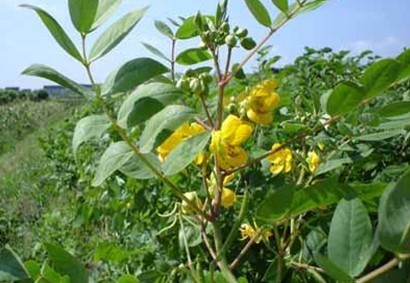Cassia occidentalis is part of the Cassia genus and its scientific name is Cassia occidentalis. The plant is reported to be poisonous to cattle. The plant contains anthraquinones. The roots contain emodin and the seeds contain chrysarobin (1,8-dihydroxy-3-methyl-9-anthrone) and N-methylmorpholine.
It is subshrubs or shrubs, erect, 0.8-1.5 m tall, glabrous, few branched. Branches herbaceous, ribbed; roots blackish. Leaves ca. 20 cm; stipules caducous, triangular to lanceolate, 1-2 cm, membranous; petiole 3-4 cm, with a large, brown, ovoid gland near base; petiolule 1-2 mm, with a rotten smell when kneaded; leaflets 3-5(or 6) pairs, ovate to ovate-oblong, 4-10 × 2-3.5 cm, membranous, base rounded, apex acuminate. Corymbose racemes few flowered, axillary or terminal, ca. 5 cm; bracts caducous, linear-lanceolate. Flowers ca. 2 cm. Sepals unequal, outer ones suborbicular, ca. 6 mm in diam., inner ones ovate, 8-9 mm. Petals yellow.
| Catalog | Product Name | CAS Number | Manual |
|---|---|---|---|
| CFN98848 | Physcion | 521-61-9 | |
| CFN98751 | Chrysophanol | 481-74-3 | |
| CFN99410 | Chrysophanol 8-O-glucoside | 13241-28-6 | |
| CFN98834 | Emodin | 518-82-1 | |
| CFN98749 | Aloeemodin | 481-72-1 | |
| CFN99572 | Emodin-8-beta-D-glucoside | 23313-21-5 | |
| CFN99916 | Beta-Sitosterol | 83-46-5 | |
| CFN97326 | Stigmasterol | 83-48-7 | |
| CFN98000 | Stigmasterol glucoside | 19716-26-8 | |
| CFN97767 | Robtein | 2679-65-4 | n/a |
| CFN97804 | Biorobin | 17297-56-2 | |
| CFN97786 | 7,3',4'-Trihydroxyflavone | 2150-11-0 |
A unique collection of 55 natural compounds from Morus alba L
A unique collection of 21 natural compounds from Saussurea lappa Clarke
A unique collection of 29 natural compounds from Ophiopogon japonicus (Thunb.) Ker-Gawl.
A unique collection of 26 natural compounds from Panax notoginseng (Burk.) F.H.Chen
A unique collection of 37 natural compounds from Lycium chinense





